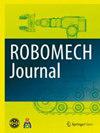远程操作机器人的信息表示方法,以支持对火灾现场的多方面理解
IF 1.7
Q3 INSTRUMENTS & INSTRUMENTATION
引用次数: 0
摘要
虽然火灾总数在减少,但随着建筑物变得越来越大、越来越高、越来越深,以及石油综合设施等危险物质设施的火灾和泄漏越来越多,特殊火灾的数量也在增加,确保消防员的安全成为一个问题。使用遥控消防机器人有望解决这一问题。重要的是能够很好地操作机器人,识别环境,并决定采取什么行动来更有效地执行消防。这与遥操作机器人的人机界面(HMI)设计密切相关,但大部分关于遥操作机器人人机界面的研究都是关于如何操作机器人以及如何呈现操作所需的信息。此外,随着火灾总数的减少,年轻消防员(新手)缺乏消防经验已成为一个问题。因此,远程操作消防机器人需要具有人机界面,使其能够识别环境并做出消防决策。本研究提出了一种基于情境控制模型(COCOM)中的控制模式的信息呈现方法,以确保新手在侦察和衰减过程中能够像经验丰富的消防员(专家)一样具有多方面的视角。12名消防队员验证了该方法的有效性。因此,本研究证实了信息呈现的设计考虑了COCOM中的控制方式,并从多个角度提高了分数。本研究结果将有助于未来遥控消防机器人的发展。本文章由计算机程序翻译,如有差异,请以英文原文为准。
Information presentation method for teleoperated robots to support the multifaceted understanding of fire sites
Although the overall number of fires is decreasing, the number of special fires as buildings become larger, taller, and deeper and fires and spills in hazardous materials facilities such as petroleum complexes is on the rise and ensuring the safety of firefighters has become a problem. The use of teleoperated firefighting robots is expected to be a solution to this problem. It is important to be able to operate the robot well, recognize the environment, and make decisions on what actions to take to perform the firefighting more effectively. This is closely related to the design of human machine interface (HMI) for teleoperated robots, but much of the research on HMI for teleoperated robots is concerned with how to operate the robot and how to present the information that is needed for operation. In addition, as the overall number of fires is decreasing, young firefighters' (novices’) lack of experience in firefighting has become a problem. Therefore, teleoperated firefighting robots are required to have the HMI that enables supports to recognize the environment and make decisions in firefighting. This study presents an information presentation method that is based on the control mode in the contextual control model (COCOM) to ensure that novices can have multifaceted perspectives during reconnaissance and attenuation like experienced firefighters (experts). The effectiveness of this method is confirmed by 12 firefighters. As a result, this study confirms that the information presentation is designed considering the control mode in the COCOM, and it improves the score from multiple perspectives. The findings of this study will contribute to the future development of teleoperated firefighting robots.
求助全文
通过发布文献求助,成功后即可免费获取论文全文。
去求助
来源期刊

ROBOMECH Journal
Mathematics-Control and Optimization
CiteScore
3.20
自引率
7.10%
发文量
21
审稿时长
13 weeks
期刊介绍:
ROBOMECH Journal focuses on advanced technologies and practical applications in the field of Robotics and Mechatronics. This field is driven by the steadily growing research, development and consumer demand for robots and systems. Advanced robots have been working in medical and hazardous environments, such as space and the deep sea as well as in the manufacturing environment. The scope of the journal includes but is not limited to: 1. Modeling and design 2. System integration 3. Actuators and sensors 4. Intelligent control 5. Artificial intelligence 6. Machine learning 7. Robotics 8. Manufacturing 9. Motion control 10. Vibration and noise control 11. Micro/nano devices and optoelectronics systems 12. Automotive systems 13. Applications for extreme and/or hazardous environments 14. Other applications
 求助内容:
求助内容: 应助结果提醒方式:
应助结果提醒方式:


